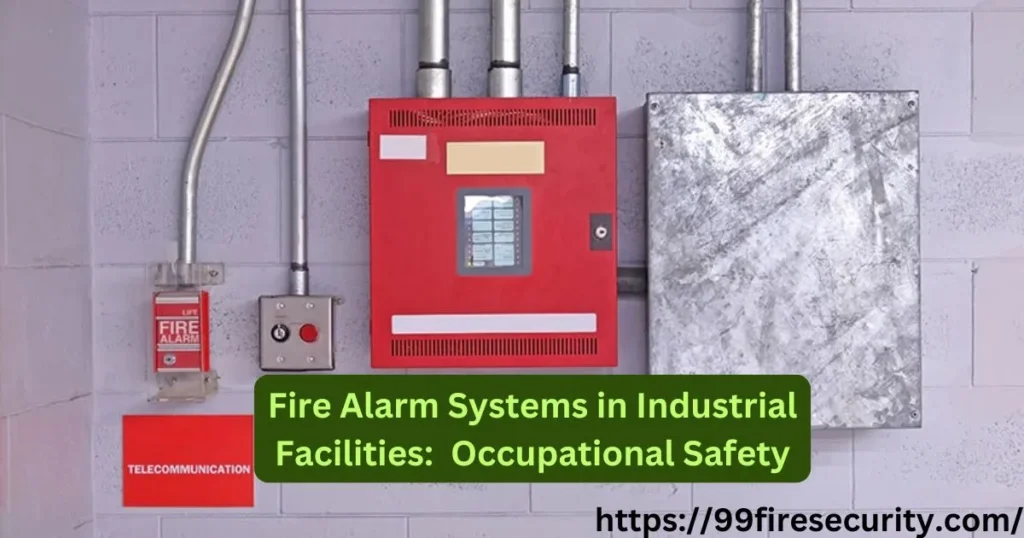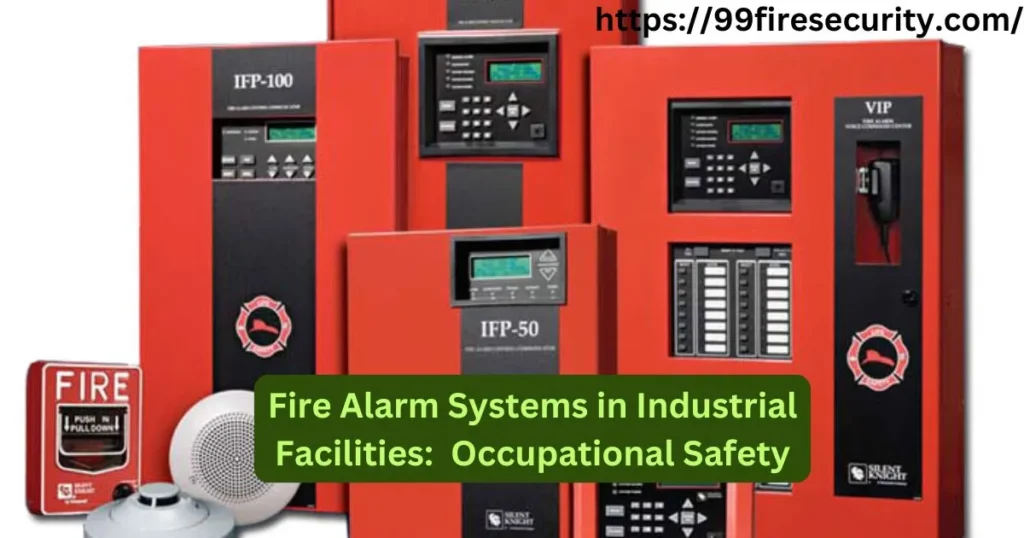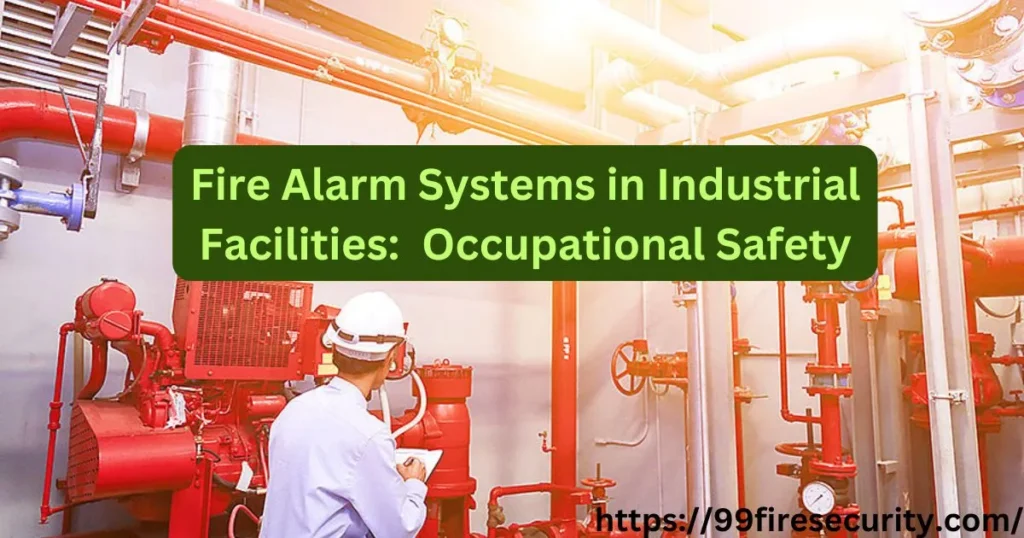Introduction
Few things in an industrial facility are as vital to the entire workplace as fire safety. The fire, a vast and complex feature of industrial services, is often integrated into the process, making fire alarm systems essential. The presence of valuable combustibles, machinery, operations, etc., makes industries and some other premises highly susceptible and vulnerable to fire hazards. With a complete fire alarm system you can help save lives, save property from being burned down and even help with business recovery.
Beyond safety, industrial facilities must comply with stringent fire prevention regulations aimed at reducing potential legal liabilities, fines, and closure due to deadly fires. In the article below we will cover major requirements and best practices for applying and ensuring fire alarm systems for industrial environments.

Learn How to Minimize Fire Hazards in an Industrial Plant
Common Fire Hazards
In industrial settings, fire threats are perennial. These include electrical malfunctions, ignitable liquids, combustible dust, equipment overheating and chemical reactions. Fire hazards are a aggravating situation involving human error, improper maintenance and equipment malfunction.
Industries and Other Facilities at a Elevated Danger
- Manufacturing plants — heavy machines, welding, flammable materials.
- Chemical Facilities – Flammable and combustible chemicals and gases.
- Storehouses — Huge quantities of goods, some of which are possible to combust
- Different types of power plants s – Electrical hazards and production of heat.
Fire Incident Case Studies
- Chemical Plants Fire – Due to improper storage of combustible materials
- FactoryElectricalFire – That is the sound of expired cabling and circuits getting overloaded.
- Fires Inside Warehouses – When Proper Ventilation is avoided + Ignition Traces.
- What you should know about key fire alarm system components
Date and Time (FACP)
Their connections are made directly to the Fire Alarm Control Panel (FACP), which is responsible for all data processing with the fire alarm system. It receives signals from detectors and activates alarms. Cheri fire, to a specific location of a fire, which cuts down on response time.
Smoke and Heat Detectors
These devices will detect smoke particles or an increase in heat over time, and trigger the alarm. Heat detectors are widely used in industrial working conditions with dust-related false alarms for smoke detection.
Manual Pull Stations
Provided in prominent locations, manual pull stations allow employees to trigger the alarms as soon as they notice a fire.
Notification Appliances
Workers require alarms, strobes, and sirens to receive alerts. Visual alerts help in noisy environments so these are visible at the time of an alert.
Alternate title is Regulatory requirements and standards
In accordance with National Fire Protection Association (NFPA) standards
- NFPA 72: Fire Alarm Systems Code covers design, installation and maintenance requirements for fire alarm systems. Adhering to NFPA guidelines leads to effective, sustainable systems.
Training data goes up until October 2023
- General Industry | OSHA standards Requirements vary by industry but all are centered around ensuring employee safety and mitigating hazards.
Fire Codes – International Building Code (IBC) and Local Fire Codes
- Standards and guidelines such as local fire codes, FEMA, ICC, ANSI, NFPA contribute to the details needed for the fire alarm system design and installation, but again they are jurisdictional because they come from very different jurisdictions which have different standards or are based on IBC. These facilities shall be subject to national and local regulations.
The following are the types of fire alarm process for industrial facilities.
Conventional Fire Alarm Systemscubicle in an office.
Ideal for smaller facilities, these systems separate the building into zones. They are cheap relative to more advancements systems but are not super accurate.
Overview of Addressable Fire Alarm Systems
These systems assign each detector an address, allowing you to locate a fire to within an inch. They also suit large and complex industrial sites perfectly.
Hybrid Systems
For medium-sized facilities, hybrid systems are the best of both worlds, providing the flexibility and scalability of an addressable system and the cost-effectiveness of a conventional.

WAKING UP THE GUARD 10 | Setting the Fire Alarm Design for Industrial Facilities
Conducting Risk Assessments
Every facility is unique. A detailed risk assessment explains the kinds of risk involves and helps inform the design of the systems.
Manufacturing Facilities Design and Layout
Zoning is useful for making geographic detectors located better at the proper areas for providing good coverage. There may also be specific detectors needed for greater fire-risk areas, such as a chemical storage area.
Scalability and Redundancy Considerations
With industrial facilities, they have the potential to expand. Systems are designed to scale, so not having to be completely replaced when operations begin to grow. Redundancies build systems of alarms so that if one part fails, alarms still function.
Integrating With Additional Safety Systems
Sprinklers, suppression systems, exit signage, and emergency lighting all have to be integrated in the fire alarm system for it to be a complete safety net.
Installation Best Practices
Choosing Able Contractors
This is because they are kept current on local codes and regulations as well as best practices. The contractors should be experienced in industrial installations
Electrical and Power Energy Electric Wiring
- Back-up power sources and protected wiring paths prevent the system from failing during a power outage or disaster.
- If there is anything at all to take away from this stuff, it is that in regards to how we understand and procedures an appraisal will be how we followed some things.
- Detectors and alarms functional, calibrated for beta testing This phase is important to ensure that performance is uniform.
Learning about: Inspection and Maintenance Procedures
Routine Inspection Schedules
Fire alarm systems in industrial facilities must not only be reliable, but they also need to be in regular inspection. NFPA 72 calls for quarterly and annual inspections, or even more for high-risk facilities. Additionally, during an inspection, we test all detectors, alarms, and manual pull stations, verifying that they are in good condition.
Functional Testing and Simulations
One approach is periodic testing to simulate fire conditions and evaluate the system response. This will vary from ensuring that smoke or heat detectors are activated, and alarms triggered — in addition to communications being maintained all the way to monitoring services. Another one of simulation’s function: exposing potential system vulnerabilities: they are not just used to test functionality.
Maintenance Tips: Common Problems and Preventive Solutions
- Too Many False Alarms – Usually caused by dust or moving equipment. She said cleaning and recalibrating the sensors often minimizes it.
- Faulty Detector – If your detector is old or damaged, it may no longer be functional. Old parts are swapped for new ones, ensuring that your system will run properly.
- Case 4 Backup batteries can fail — Backup batteries require replacement on a schedule or can cause system outage.
Record Keeping and Reporting
Regulated environments must maintain detailed logs of inspections, tests and servicing. Having the right kind of documentation is paramount in this case and keeps the facility audit-ready while also proving compliance whenever audited by fire safety mechanisms.
Importance of Fire Safety Education
In the case of fire emergencies, employees are the first line of defense. Making all of your staff aware of fire hazards, how to use the fire alarms and what to do during a fire emergency only serves to make your property more safe.
Conducting Fire Drills
Drills help workers learn how to evacuate buildings and familiarizes them with alarm systems. These should be conducted at least twice a year and the scenarios used should be diversified to prepare for a range of fire risks.
Evacuation and Roles assignments
Evacuation is made efficient by assigning task roles (fire wardens or evacuation leads for example). Prior planning also allows for the implementation of adequate safety measures, such as ensuring that industrial premises have multiple exit points, that evacuation routes are clearly marked, and that assembly points are designated for the best orderly evacuation.
It is an ongoing evolution of a safety culture
Continual education, informative signage, and frequent refresher courses help foster a culture of safety at the workplace. The goal: Workers feel empowered to respond to a fire alarm, and recognize the importance of vigilance.
Challenges that occurred typically with | How to track them
- Addressing False Alarms
- False alarms can disrupt; they can even causeabsoluteapathy. To reduce false triggers:
- These areas should have heat detectors suitable for dust or steam.
- Implement dual-detection systems, where it takes two detectors to register an alarm before alarms are sounded.
- Sensor failure is avoided due to the maintenance of the equipment.
Retrofitting Older Facilities
Those outside urban centers, most older industrial plants may have no such modern fire alarm infrastructure whatsoever. Such upgrades typically involve connecting new addressable systems with existing wiring, to save money. Extensive installations of parts, which could be brought in modally, to supplement existing functioning.
This is the case with the treatment of hazardous areas and materials capable of explosion.
Hazardous Zone application: these application applications used flame sensors or gas detection systems. In places storing chemical materials or easily exploded gas materials, explosion-proof fire alarm equipment has to be adopted.
Cost-effective solutions in challenging funding times
Risk assessments promote targeted fire alarm installations for better budgeting. Installation costs can also be offset by grants, tax incentives and insurance discounts.
Fire Alarm Systems — Emerging Technology
Smart Fire Detection with IoT Architecture
IoT Used in Fire Alarm Systems In Today WorldIoT sensors and real-time data analytics are now incorporated into modern fire alarm systems to detect anomalies before the fires have a chance to spread. Such systems can monitor atmospheric conditions such as temperature, humidity and greenhouse gases to send out alerts.
Fire Detection System Based on Artificial Intelligence
Fire data from such sources as 911 calls help train AI algorithms that minimize false positives and optimize response times. AI can differentiate between smoke generated by machine and smoke from a real fire and enhance detection accuracy.
Wireless Fire Alarm Solutions
Wireless systems are more straightforward to install, especially in large or dangerous environments. These systems can blanket sprawling industrial areas without the cost of much wiring, saving on labor and materials expense.
Remote Monitoring and Management of
Fire alarm systems that communicate to the cloud for example allow facility managers to remotely observe operations. Faster response time = less damage by fire.
Legal Liabilities and Risk Management
Penalties for Violation
Treno added that in extreme cases, failure to have in place or maintain fire alarm systems could result in large fines, the shutdown of operations, and even criminal charges. There are a lot of successful lawsuits involving fires that could have been prevented and therefore make it all the more beneficial to follow fire safety standards.

Coverage & Insurance Requirements
Insurance policies will not be available from many companies unless systems comply with codes, Eberhart said. The right fire protection systems help reduce projected losses, as well as lower premiums and improve overall risk ratings for industrial facilities, too — boosting profitability and giving a full 360 degree overhaul to carrier relationships.
Types of Lawsuits Related to Fire Incidents
- Warehouse Fire – Significant Inventory Loss and Lawsuits due to Inoperable Alarms
- Factory explosion (no fire detection) – resulted in worker deaths, regulatory action and huge financial penalties
Industry Specific Fire Systems: How To Tailor?
Manufacturing Plants
Zone-based detection systems are required for these facilities to keep up with various production areas. Specialized sensors may be needed for situations with welding activities and high temperatures.
Industrial Plant Process Industry Facilities: Chemical & Petrochemical
Chemical Plant Fire Alarm Systems need Gas Detectors, Flame Sensors, and Explosion-Proof Tools. The risk of the spread of fire is one of the highest among such instances, hence prompt response systems are very critical.
Warehouses and Storage Units
Warehouse addressable fire alarm systems can monitor large spaces. Perfect for high and ceiling places like warehouses, these detectors.
Electrical Power Generation, Transmission & Distribution
Electrical fires pose the greatest risk to power plants. Conditions in these environments will sometimes require enhanced arc-fault detection and temperature monitoring systems to provide additional layers of protection.
Environmental Considerations
Several places have commercial fire alarm systems installed.
Fire alarm systems for severe environments are essential for industrial facilities working in extreme conditions — be it heat, cold or humidity. Heat and waterproof equipment should be placed in this space.
No weather and explosion-proofing equipment
For outdoor facilities and hazardous environments, weatherproof enclosures and explosion-proof sensors will help to ensure continuous protection.
Answering High Humidity, Dust and Corrosive Atmospheres
Dusty industrial environments like mines and processing plants require specialized detectors that resist contamination.
Latest Trends In Fire Alarm Systems
Training is supplied on data as much as October 2023.
This session will examine the need to evolve fire detection technology, emerging trends in patterns of fire detection, and an assessment of how the new, improved methods measure against the fast-forward stakes of modern construction.
Relay On Sustainable And Eco-Friendly Fire Detection Systems
The manufacturers have developed images of fire detection systems that are energy-efficient and can be recycled, which reduce environmental impact.
“Data Driven” Decision Making in Operations
Predictive Maintenance — An example of this is using AI to predict failure states in systems before the system fails, minimizing downtime and therefore maintaining fire protection.
Conclusion
Industrial plants use fire alarm systems that make essential role in protection and continuity of business. From meeting regulatory obligations to employing the latest technology, robust fire detection and alarm solutions help to mitigate fire risk, safeguard employees and protect assets. Systems can stay in service for many years, providing effective fire protection with the proper maintenance, training, and system upgrade.
FAQs
Which ones commonly cause false alarms in industrial fields?
Dust, steam and mechanical vibrations often produce false alarms.
Why the Internet of Things is improving fire alarm systems?
IoT can enable them not only for real time monitoring but predictive analysis also which is greatly enhancing the accuracy of fire detection.


